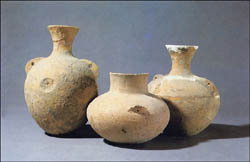
Researchers discovered remnants of a fermented drink in fragments of 9,000-year-old Chinese vessels such the three in the picture.
(credit: Z. Zhang/Inst. of Cultural Relics and Archaeol. of Henan Province)
Our ancestor may raise a toast with the earliest known wine while having a piece of music from the oldest known musical instruments about 9,000 years ago.
Physical evidence have recently confirmed that ancient Chinese were producing fermented, wine-like drinks from rice, honey and fruit as early as in 7,000 B.C. according to scientists who are examining residues of the ancient shards of pottery from a Stone Age site in north China, where the oldest playable instruments--flutes made from bones--were found in 1999.
This traces back the Chinese history for making alcoholic drinks 4,000 years earlier than people previously thought, moving up the date for the world's first tipple by at least one thousand years.
The discovery is the result of an interdisciplinary cooperative study among Chinese, U.S. and German scientists. Two CAS researchers, Prof. Zhang Juzhong from the University of Science and Technology of China and Prof. Cheng Guangsheng from the Institute of Microbiology, are among the collaborators. Their work was published online in Dec. Issue of the
Proceedings of the National Academy of Sciences in the US.
The evidence comes from the early Neolithitic village of Jiahu (7000 to 5500 B.C.) in Henan Province, which has been excavated under the leadership of Prof. Zhang since 1984. Over the past five years, an international team led by Prof. Patrick E. McGovern of the University of Pennsylvania Museum of Archeology and Anthropology began work on the residue that had collected inside the pots.
Chemical analyses of ancient organics absorbed into the Neolithic pottery jars show a mixed fermented beverage made from rice, honey, and fruit (hawthorn fruit and or grape). This prehistoric drink paved the way for unique cereal beverages of the of the proto-historic second millennium B.C., remarkably preserved as liquids inside sealed bronze vessels of the Shang and Western Zhou Dynasties (1250--1000 B.C.), note the researchers.
Together with the beverage at Jiahu, the researchers have also examined some other liquids inside sealed bronze containers which have been excavated at elite burials from Shang Dynasty in Anyang City and from an early Zhou Dynasty mausoleum located in the site of a Taoist shrine Taiqinggong in the county of Luyi, both two sites being in Henan Province.
The samples were studied through several lines of chemical analysis, including gas chromatography-mass spectrometry, high-performance liquid chromatography-mass spectrometry, Fourier-transform infrared spectrometry and stable isotope analysis. It was found that the chemical composition of the samples is similar to those in modern rice, rice wine, grape wine, beehive wax, tannins, several herbal medicines (ancient and modern) and hawthorn. The most straightforward interpretation of these data, according to researchers, is that the Jiahu vessels contained a consistently processed beverage made from rice, honey, and a fruit. Because of the presence of the honey, the researchers speculate that the drink must be sweet and delicious.
Before the Jiahu discovery, the earliest evidence for an alcoholic drink in human history was the resinated wine inside two jars excavated in 1994 at the Neolithic site of Hajji Firuz Tepe, Iran, dating to about 5400 B.C. And scholars used to think an alcoholic drink make its first appearance in China during the period from the late stage of the Yangshao Culture to the Longshan Culture about 5,0000--4,000 years ago.







